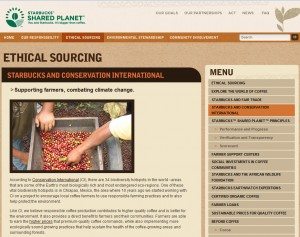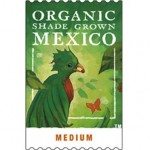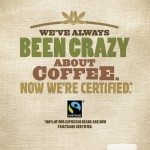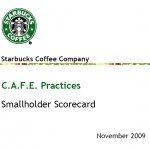 Welcome to your introduction to Starbucks C.A.F.E. practices and Shared Planet; On Mystarbucksidea.com, the site is intermittently flooded with people who yell, “Starbucks needs to sell more fair trade coffee”. This blog post is in response to those cries for ethically sourced coffee. Let’s talk about coffee sourcing – this blog post is your very basic introductory blog about responsible coffee sourcing. I might later write a more detailed discussion about C.A.F.E. practices.
Welcome to your introduction to Starbucks C.A.F.E. practices and Shared Planet; On Mystarbucksidea.com, the site is intermittently flooded with people who yell, “Starbucks needs to sell more fair trade coffee”. This blog post is in response to those cries for ethically sourced coffee. Let’s talk about coffee sourcing – this blog post is your very basic introductory blog about responsible coffee sourcing. I might later write a more detailed discussion about C.A.F.E. practices.
It is essential to realize that there is more than one way to ethically source coffee. “Fair Trade” is a label. That bears repeating. It is just a label. Coffee with other labels related to their sourcing are equally responsibly sourced. Just because you don’t see a “fair trade” label doesn’t mean that it’s not sourced with the utmost concern for farmer and environment. Starbucks has adopted the “Shared Planet” label as the label you can trust for responsible coffee.
First off, there is so much information that it is almost difficult to figure out how to compile it for an introductory ethical bean sourcing post. Perhaps it would be wise to remind my readers that the lingo “Shared Planet” is really a new way of Starbucks describing what they already had been doing for over a decade – responsibly sourcing coffee. Starbucks has always sought to pay more than the market price of coffee, and ensure that coffee beans were sourced ethically and preserve the biosphere of the farm region, but a turning point in how Starbucks accomplishes this came in 1998.
******
Background: Organic Shade Grown Mexico Coffee, 1998
In 1998, Starbucks entered into a partnership with Conservation International, a non-profit organization, to develop a plan to responsibly source coffee from the Chiapas region of Mexico. The goal of the partnership was to preserve the healthy shade canopy of the region’s farms, and create sustainable farming practices for the region’s farmers. It was a three-year pilot program out of which Starbucks launched Organic Shade Grown Mexico coffee, and the participating farmers saw their income rise, received technical assistance from Conservation International field staff, and developed on-going trade relationship with Starbucks. You can read more about the history of Organic Shade Grown Mexico on the Conservation International site, here.
This initial three-year pilot program grew into a long, on-going relationship with Starbucks that continues today. In 2008, Starbucks agreed to another 5-year partnership period with Conservation International.
******
C.A.F.E. practices – The next phase for Starbucks
From the experiences of working with Conservation International, Starbucks began to formalize and adopt its policies for coffee sourcing. In 2003, again with the cooperation of Conservation International, Starbucks launched its first formalized and third-party verified coffee bean sourcing standards, known as C.A.F.E. practices. It is important to note that Starbucks had always believed in ethically sourcing coffee, but previously did not have a rigid program and yard stick to measure how well they were living up to the goals for responsibly sourcing coffee.
C.A.F.E. practices stands for Coffee And Farmer Equity Practices. Under C.A.F.E. practices, each participating farm is audited by third-party verifiers (meaning these are not Starbucks employees, but rather disinterested third parties) for compliance with a long list of standards. The ‘standards’ look at everything from compliance with local wage law to total hours worked by farm workers, to access to health care and education, to maintenance of buffer zones of water bodies on the farm. The ‘standards’ scoring sheet is far too lengthy to reiterate here in full, but suffice it to say, each farm is scored on a broad array of topics relating to labor, environmental, and social responsibility practices. Some topics on the ‘score card‘ are considered zero-tolerance, and if the farmer fails in one of these areas, no matter how glowing his performance otherwise, the farm cannot be certified as a C.A.F.E. practices farmer.
C.A.F.E. practices continues today, and is still the program by which coffee farms must live up to to a certain standard to bear the “Shared Planet” symbol on the coffee packaging. Starbucks incentivizes the farmers to constantly improve their C.A.F.E. practices scores with monetary incentives. The general structure of the incentive is that with higher scores, the farmer will be paid more for his green coffee beans.
******
What is Shared Planet?
![]() Shared Planet is what Starbucks calls its program for comprehensive analysis and report for all of its “green” activities. For example, Shared Planet reports on everything from the number of customers using a personal cup, to the percentage of stores which are LEED Certified, to donation and giving that Starbucks is involved in. The coffee sourcing guidelines under C.A.F.E. practices are one piece of a larger plan as Starbucks strives to be a company with a social conscious. For example, I heavily reference the Shared Planet report on my prior blog entry on the Starbucks personal cup and recycling:
Shared Planet is what Starbucks calls its program for comprehensive analysis and report for all of its “green” activities. For example, Shared Planet reports on everything from the number of customers using a personal cup, to the percentage of stores which are LEED Certified, to donation and giving that Starbucks is involved in. The coffee sourcing guidelines under C.A.F.E. practices are one piece of a larger plan as Starbucks strives to be a company with a social conscious. For example, I heavily reference the Shared Planet report on my prior blog entry on the Starbucks personal cup and recycling:
In the Starbucks blogs on mystarbucksidea.com, in October 2008, Starbucks produced a good overview of the kinds of topics Shared Planet touches on and you can read that here:
****
Why doesn’t Starbucks buy all Fair Trade coffee?
 Many people may hear about C.A.F.E. practices but still wonder, ‘why doesn’t Starbucks just buy all Fair Trade coffee?’ Fair Trade is a label, and farmers have to go through certification, and pay a Fair Trade association fee to be part of the Fair Trade. Even the most responsible farmer who takes care of his workers and farm will never become Fair Trade certified if he or she decides that for whatever reason, not to pay the Fair Trade association fee. The percentage of farmers who are Fair Trade certified is small, and there are not enough beans from Fair Trade farms to supply all of Starbucks needs.
Many people may hear about C.A.F.E. practices but still wonder, ‘why doesn’t Starbucks just buy all Fair Trade coffee?’ Fair Trade is a label, and farmers have to go through certification, and pay a Fair Trade association fee to be part of the Fair Trade. Even the most responsible farmer who takes care of his workers and farm will never become Fair Trade certified if he or she decides that for whatever reason, not to pay the Fair Trade association fee. The percentage of farmers who are Fair Trade certified is small, and there are not enough beans from Fair Trade farms to supply all of Starbucks needs.
It’s important to know that how the coffee beans are sourced doesn’t necessarily correlate to the quality of the coffee bean. A responsible farmer using C.A.F.E. practices, organic practices, Fair Trade certified may still produce inferior beans that Starbucks rejects as too low of quality. The beans could have insect damage, mill damage, or for any number of reasons, not be of an adequate quality for Starbucks coffee buyers.
Starbucks produced a short essay on “Why Isn’t All Your Coffee Fair Trade Certified?” and it is definitely worth reading:
In late 2008, Starbucks announced that they would nearly double their purchasing of Fair Trade coffee for 2009, increasing to nearly 40 million pounds of Fair Trade certified coffee. Starbucks is the single largest purchaser of Fair Trade coffee. You can read more about their commitment to expanding Fair Trade coffee buying here:
******
Conclusion
That wraps up a very basic introduction to a couple of different ideas related to coffee sourcing with responsible means. In conclusion: (1) There is more than one way to responsibly source coffee – it doesn’t have to have a particular kind of a label (2) The sourcing guidelines don’t necessarily tell you about bean quality and (3) Starbucks does support Fair Trade, but there is not enough Fair Trade beans to supply all their needs. Any number of these topics might be expanded later for more detailed blog posts. I also recommend that you read the prior blog entry on Sumatra sourcing, which has some unique aspects to it:
Related posts
18 Comments
Leave a Reply Cancel reply
You must be logged in to post a comment.
Sponsors
Recent Comments
- DEVIN on Compostable Straws Land in Seattle Starbucks Stores
- coffeebeanz on Why do you go to Starbucks less often? (If that’s true for you)
- Willi on You can now buy a Siren statue: $6,000
- Willi on A major revamp of your drink recipe: Testing syrup extracts and cane sugar
- Skip on Why do you go to Starbucks less often? (If that’s true for you)







Thank you for this 😉
(Reply @CABarista) – You’re welcome! I wanted to write some basic coffee sourcing essay so that if I needed to, I could reference it in my comments on MSI. There is no way to write a long comment on MSI without it being annoying because there are no paragraph breaks in MSI comments.
This is really one long MSI comment as a blog post!
When I read articles like this, I’m boggled thinking about the size of Starbucks and their ability to purchase so much ethically traded coffee. Shared Planet, CI, CAFE practices, Fair Trade, USDA Organic, etc… these are all reasons why it feels good to work for Starbucks (and buy from them, too.) Seriously, that’s a lot of coffee! Coffee touches so many different hands before it even gets to a Starbucks store. The farmer, the Starbucks quality team, the CAFE practices people, the roasters, etc.! CRAZY! LOVE IT!
Btw, I know it’s not kosher to say this, but these kinds of blog posts I feel quite proud of. It’s a good message, and I’m proud of how I can present things in a fairly easy to read and follow format!
Melody, thank you for this! I know we know all this stuff but this website might help others learn about the awesome we do… 😉
it’s a shame that they have to pay a fee to be involved in “fair trade” – doesn’t seem fair to the small farmer who is struggling to be ethical.
Amazing!!
Thanks for breaking up each topic and describing so well.
I didn’t know the there was a Fair Trade fee to be involved. I agree with Rachel. It’s not fair!!
Great article! I learned a lot. I already knew about the fair trade label being more like a brand, then an end all be all. That’s definitely word that needs to get out because all of the different labels on coffee in general can get pretty confusing and leaves the coffee buyer wondering what exactly they’re buying.
that is why I so appreciated this post 🙂
Hey Melody, I can’t thank you enough for posting this. Not a lot of our customers know about Shared Planet and we get questioned a lot why our coffee isnt fair trade. I think this will help clear up the confusion any of customers have. Thanks again.
See you around
-Akoni
awesome blog post!
Thanks for this, Melody. I love, LOVE talking to customers and other partners about the amount of good Starbucks actually does.
(Reply to CABarista, JP,Akarisame, Rachel,VentiBold, BaristaAkoni, MikeCrimmons, and Hallie) – I definitely appreciate ALL the comments.
On the topic of association fees, I’ve heard that there is one large up front fee to join FT, and then annual much smaller fee thereafter. This really is a big issue for the small farms – If you’re a small farm in Latin America, I bet this feels like paying a major expense.
@MikeCrimmons – I’ve actually heard that there are a number of different kind of certifications that a farmer can go through – One problem for the farmer is trying to get certified multiple times over for varying standards. Confusing.
Keep spreading the word! We need to get both customers and many partners up to speed at least on this kind of basic stuff.
If I could have 30 minutes of Howard Schultz’s time, one thing I would ask about what Starbucks is doing with Conservation International right now. The partnership with them has been ongoing continously since 1998, and in 2008 it was renewed again. I’d like to hear some real specifics about the kinds of things Starbucks and CI are doing together right now…
I think thats a great blog entry.
(Reply to BostonStarbucksRebel) – Coming from you, that is a high praise. Thank you!
EXCELLENT!!! I understood the concept of fair trade but hadn’t researched it myself. I didn’t realize that those farmers had to pay a membership fee! I like starbucks developement and use of “Shared Planet” it makes much more success. To me it comes across as farmers are getting recognition for quality vs. quantity 😀
Hello:)
[…] its coffee is sustainably grown and processed. If all this information is overwhelming, there is a blog that explains it very well (although it openly supports Starbucks, so it may not be a perfectly […]